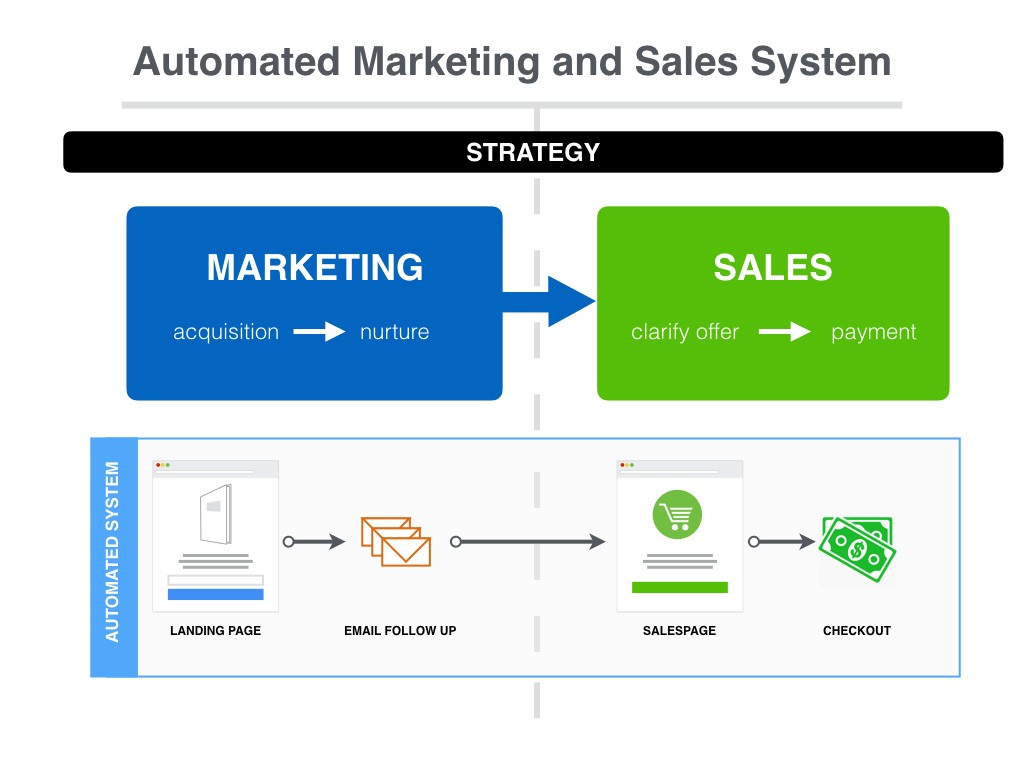I was recently asked by a good friend of mine the difference between marketing and sales.
For a while he was coupling them together as the same process in his mind.
The question challenged me for a minute until I realized they are totally separate processes. Both working in conjunction with each other to achieve a common goal, but separate.
After responding to his question I decided to create a visual representation of exactly how I see marketing and sales and where automation plays its part.

Let’s start from the top…it all begins with your strategy.
Strategy
I can’t stress enough how important your strategy is when it comes to marketing and sales. It is your strategy that determines what you do and how effective it is.
Without it you will find yourself building a look-a-like business based on the appearance of other entrepreneurs’ business. It will look similar but you won't get the same output (thousands of websites fall victim to this).
In fact, it's not just the effective use of marketing technology that creates websites that convert leads, it's more about the strategy that you deploy to leverage the technology.
I have seen a lack of sound strategy range from the start up entrepreneur to the start up company looking to scale. Many have tried to succeed without one, all have failed.
That is why I have strategy illustrated as the top layer of your entire system. Your approach to marketing and sales should be a strategic one with clear goals and outcomes defined before you start building anything.
If you don’t have a clear strategy, don’t worry, the questions in each section will help you get started in generating one.
Marketing
Marketing is the process of aligning the needs of your prospects with your product offering through lead nurturing.
This is done in two stages: 1) Acquisition and 2) Nurturing
At the acquisition stage the main questions you should be able to answer are…
How will I acquire new leads?
- Will you rely on paid media or organic traffic?
- Where will these leads come from (social media, guest posting, podcasting, etc)?
- What will I offer?
This is going to require research on your target audience to understand their needs and “dreams”. Since you know what your product offers you should be able to identify the type of person who needs it the most.
Now it’s time to offer a piece of your product for free (this is called a “LeadMagnet) to these newly identified prospects on a landing page to start the acquisition process.
Once acquired the next step in marketing is nurturing.
The purpose of nurturing your leads is to build a strong relationship and rapport during the decision making process. Most leads you acquire will not be ready to make a purchasing decision immediately and will need some ongoing education, proof, and information to get ready.
This is the purpose of your email follow up sequence. But we’re not just sending emails for the sake of sending them. Remember…you need to be strategic. Every email should have a purpose. To help you identify the purpose of your emails ask yourself the following questions:
What additional information do these prospects need in order to make purchasing decision?
- What information do they need to make a buying decision that they don't have yet?
- What results have other customers achieved with my product?
- What is the biggest objection when it comes to buying my product?
The answer to those questions will determine the content of your emails.
Successful marketing should “prime the pump” for sales. Marketing feeds the sales process with informed leads excited to take the next step. You shouldn’t start the sales process any sooner.
Sales
Sales is the process of exchanging money for your product.
This is a delicate process that requires the ultimate form a clarity. Especially if the sale is taking place digitally without human interaction.
The two stages of sales are: 1) Clarify your offer and 2) Process payment (immediately)
The clarification stage is where your newly marketing leads arrive. Now it is up to your sales page copy to ensure that it is very clear what you are offering and how they can purchase it.
Some good questions to ask yourself at this stage are…
What are the main benefits to my product?
- How will someone’s life/business be better because of it?
- What are they missing out on by not having it?
- How fast will their life/business improve?
Your ability to answer these questions with the utmost clarity will be the deciding factor on whether or not you create a new customer.
Take your time and map this out because confusion doesn’t convert. If their is just an inkling of confusion on whether your product is a good fit for your prospect they will not buy.
Last stage is the payment.
You’ve done a good job acquiring, nurturing, and clarifying your offer. Your prospect has clicked on the call to action button on your sales page and is ready to give you their money.
You should be able to take their money AND deliver the product immediately. Any delays or hiccups in this process and you can kiss your revenue good bye.
A good question you should ask yourself at this stage is…
How will I deliver my product?
- Is it a digital product they download?
- Do I need to do any form of manual fulfillment?
- Are there any login credentials that need to be sent?
Although the answers to these questions should be answered on your sales page it is good to go through this exercise and answer them beforehand.
This is probably the most technical part of the entire process. For most entrepreneurs there is some integration between their payment processor and their delivery system that needs to take place in order to execute this in a smooth and automated fashion.
But once in place you have a fully functional automated marketing and sales system.
Remember, you need to pay attention to both marketing and sales to build a successful business. You don't need to be a master, but you need to be effective at both. They are equally important.
If you find yourself generating lots of leads with no sales…you need to work on your sales skills.
If you find yourself with no leads but you have no problem converting leads…you need to work on your marketing skills.
If you have neither leads or sales…check your strategy.
As always…thoughts and comments always welcome below.
